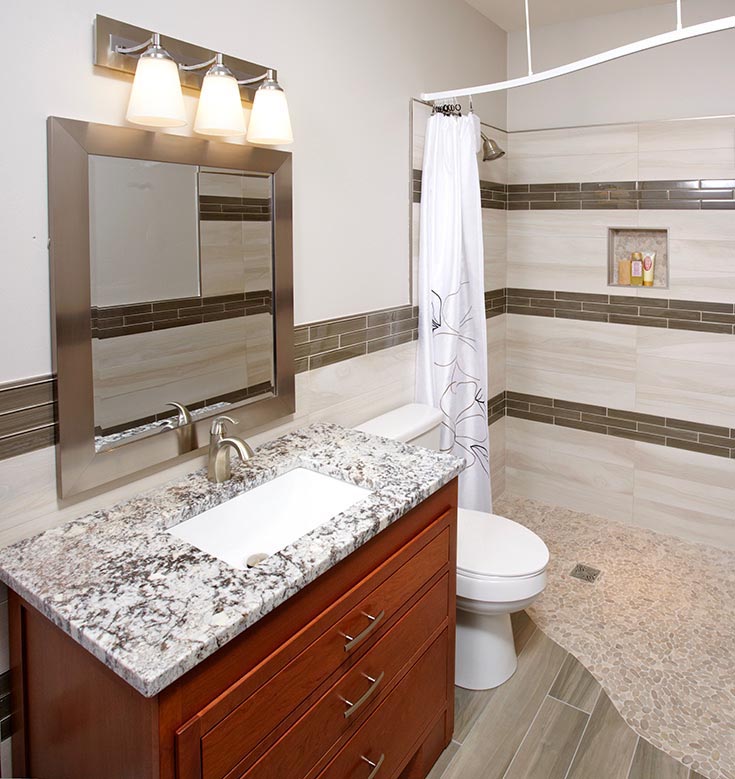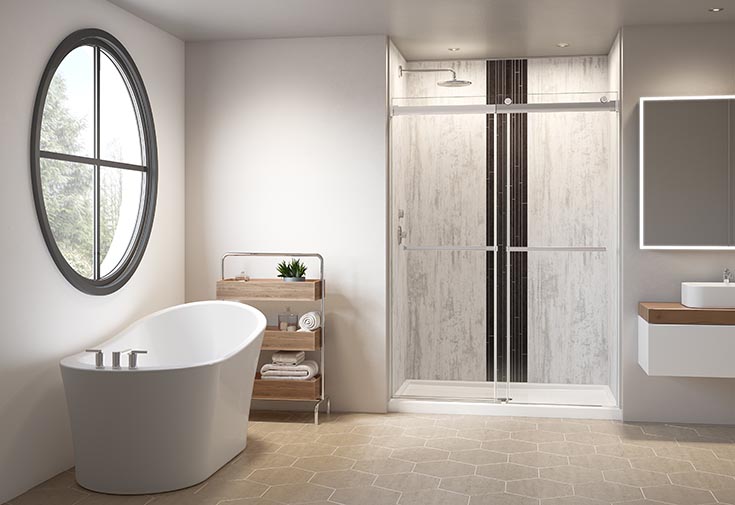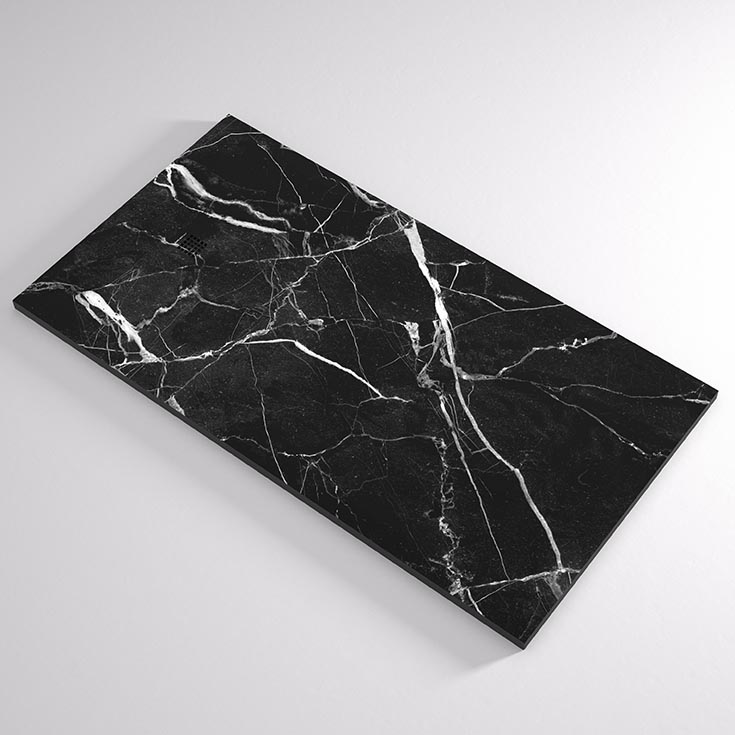How to choose the best shower pan

I’ll bet you’re saying right now, “Wow – I get to choose a shower pan. How could my life – and this bath remodel – become even more fun?”
And I’ll admit choosing a shower pan for a remodel or new home IS NOT as much fun as selecting a stylish vanity, or cool countertop, or unique shower wall surround panels. However, here’s the rub. Your vanity, countertop, or wall surrounds won’t cause as big of problems as you can get if you buy a cheap shower pan and it fails.
This is because shower pans which leak or crack lead to unexpected repairs (as opposed to ‘expected repairs’) which can force you to remove the entire shower. This can ‘transform’ you from being a homeowner to being a ‘home-moaner.’ This IS NOT a place you want to be.
So, if you’re wondering how to choose this important – yet not the most exciting part of your remodel– the shower pan, you’ve come to the right article.
I’ll evaluate the best shower pan by looking at different features of shower bases and talking about alternatives for each criterion. At the end let me know if there’s one type of shower pan you think would be perfect for your project. Now, let’s dig in.
How to choose the best shower pan for your budget
While it can be tempting to save money and buy the cheapest shower pan, this can be a B-I-G mistake (especially if it fails and leaks onto the floor below AND requires you to replace the materials above the pan- including the walls, glass door, accessories etc.).
However, if you want the cheapest shower pan (which will also be the flimsiest), that choice would be a fiberglass shower pan.
The step up from fiberglass are acrylic shower bases. And if you do use acrylic, look for units which have reinforcements underneath the top surface. These bases are stronger and won’t squeak when you walk on them (like you’ll see with cheaper acrylic and fiberglass bases).
The next level in the pricing ladder are solid surface shower pans. These pans are thick, durable, – but will be more expensive than fiberglass and acrylic.
And the most expensive bases are tile shower pans. Tile shower pans – offer a ton of design flexibility, but the labor costs to install a tile base drive prices up.
How to choose the best shower pan if you want to make sure it DOES NOT leak!
If I was oversimplifying this conversation I’d tell you there’s two types of shower pans.
- Those with grout joints – ‘er tile shower pans.
- Those without grout joints.
And if I was further simplifying it, I’d tell you grout joints are porous and have a higher likelihood of leaking.
And while this simplification is true, it IS an oversimplification. If you have your heart’s set on a tile shower pan – but want to protect against leaking then you need a waterproof tile shower pan system. There are component based tile pans (like those made by Wedi and Schluter) and there are expanded polystyrene ready for tile shower bases. If you want a tile shower, use one of these systems to protect your bathroom remodeling investment.
Now – when it comes to shower pans without grout joints they should all be a ‘slam-dunk’ to never leak, but this also isn’t completely the truth. You see if you buy a cheap shower pan (made of fiberglass or thin acrylic) they’re more likely to leak than a solid surface or cultured marble shower base.
Whatever you do – buy a pan you’re confident won’t leak! That’s a disaster you’ll want no part of.
How to choose the best shower pan if you want it be safe and protect against falls.
No matter how much you pay for a shower pan – it’s cost will pail in comparison to the cost of a hospital stay caused by a family member falling inside the shower pan – or while getting into or out of the shower.
And it’s for this reason, if you’re looking for either an accessible shower pan – or just a shower base which will work well in an age in place bathroom you need to know your options. Towards this end let’s first look (in descending order) into shower pans (or one level wet room systems) which are simplest to enter and exit.
- A one level wet room – A wet room system is where the ‘shower pan’ (or shower base former as it’s called) is set onto the joists – and the shower – and bathroom floor – are all waterproofed. This is the safest system because the shower and bathroom are at one level and there’s no curb (also called a threshold) to trip over. The drawbacks of this system is its more expensive than a traditional shower pan, and many contractors aren’t familiar with how to install them.
- A ramped shower pan – A ramped shower pan is set on the subfloor and has a ramp which is either attached (or detached) to make it simple to roll in with a wheelchair. This is safe for wheelchair user. My preference is the detached ramp because you won’t be stuck with a ramped pan when you sell the home. And the reason why an attached ramp is bad is because some prospective buyers won’t bid on a home with a ramped shower designed for a wheelchair user (just keepin’ it real!).
- A low profile shower pans – This is becoming the most popular pan on the market today. Low profile pans have curb heights from 1” to 3” high. They’re simple to enter and easy to install because they’re set on the subfloor. The only thing to note is with lower height, low profile pans (say 1” high) you’ll want to use a glass shower door (or a water stopper with shower curtains) to reduce the risk of water spilling onto the bathroom floor.
- A mid-height shower curb – This pan has a 2 ½” to 3 ½” curb. It’s good for a shower with curtains or a glass shower door.
- A full height shower curb – This pan has a 4” to 6” high curb. I’d minimize using this height (because falls will be greatest here) unless you have a small stand up shower and want more area for water to pool when the drain clogs.
In addition to the height of the shower curb pay attention to the texture of the shower pan itself. A base with texture is generally better than a smooth surface.
How to choose the best shower pan if you want it be easy to clean.
If you’ve ever owned a tile shower pan you know it can be a P.I.A. to clean. And if you want a simple to clean shower pan stay away from tile (unless you have the disposable income to pay SOMEONE ELSE to do your cleaning). Grout joints which get dirty and moldy are no fun.
The other shower pans which can be difficult to clean are fiberglass bases. While you’ll find a slew of ‘home remedies’ to clean fiberglass shower pans which have mold or dirt caked into them – most people give up cleaning them and replace the pan with something else when they get around to a bathroom remodel.
If you want a simple to clean shower pan, solid surface, or a cultured granite shower pan are the way to go.
How to choose the best shape for your shower pan.
Shower pans – just like people – come in many shapes and sizes.
However, when possible (and in order to save money) it’s best to use standard shaped shower pans for your project. The good thing about standard shaped pans is they’re made in molds and are more cost effective.
In the standard shapes you’ll find corner shower pans which are square, round, NEO angle (with a door in the middle of the two 45 degree angles), or rectangular. If you’ve got a small bathroom the square, round, or NEO angle pans are most space-efficient.
For an alcove style shower (one with 3 walls on the inside) the rectangular standard shower pan (with wall surrounds for the other 3 sides) are popular. You’ll find them in common sizes including 48” x 32”, 48” x 36”, 60” x 30”, 60” x 32”, and 60” x 36.”
If you want a ‘walk in shower’ with a framed wall in the front, you’ll need a custom offset shower pan. You’ll find these made of solid surface or cultured granite and are made to order (‘er that’s the code word for they’ll be more expensive and take longer to get).
It is possible to get custom shaped pans with unique angles and even round shapes. However, be prepared to pay more. And you’ll need to invest in ones made of solid surface or tile because standard acrylic and fiberglass pans can’t be customized.
How to choose the best shower pan if you aren’t sure of the exact size before you demo and want to maximize your design options.
In a perfect world you know the right size pan before you start the job. And you have it ready to go BEFORE demo day begins.
However, in the real world, it may be impossible to know the exact size you need before the old shower is removed – and it may be tough to know the exact drain location as well. So, what can you do to maximize your flexibility if you don’t know the exact size you need before you start? Here’s 2 options:
Option 1 – Buy a shower pan which is ‘trimmable’ – Few people realize there are shower pans which can be trimmed to fit specific openings – but they do exist. Trimmable pans have flanges which ARE NOT factory installed. The flanges are put on the pan after it’s cut to size. There are better quality solid surface pans which are trimmable – and you’ll also find (but it won’t be easy) plastic shower pans which are trimmable.
Option 2 – Buy a component based tile shower system – Manufacturers like Wedi have tile shower pans which are site-assembled with components which can be cut to size during the installation process.
How to choose a shower pan if you want (or need) seating.
OK – I’m going to tell you right off the bat I’ve got a bias here. And the bias is this…..
I HATE, HATE, HATE shower bases with seats built into them!
And right now, you may be asking, “Mike, why do you hate these bases?”
Well, to begin with most people don’t have showers which as large as they’d like. Then if you have a shower pan with a seat built into it (note – you’ll usually see this option in fiberglass and acrylic pans) it not only sucks up a lot of room – it’s also significantly more expensive, and you have no say on the size OR location of the seat.
It’s for this reason, if you need seating – my preference is to buy a shower pan WITHOUT a seat molded into the base and use a fold down seat instead. There’s a nice selection of stylish shower seats (unlike the ugly ‘medical-supply-store’ shower chairs) and they can be folded down when in use and folded up when they’re not needed. Plus, you can buy the size (and style) you like and (with the proper backing) place it EXACTLY where you want!
The only time I recommend installing a fixed bench seat is if you’re building a large custom shower and can afford the space.
How to choose a shower pan if you don’t want to look at an ugly drain.
While shower pans aren’t the sexiest part of your bathroom remodel– they can get even uglier (if that’s possible) if you have an ‘old-school-looking’ round shower drain in a finish which has seen its best days years ago (are any of you staring down a pitted, bright brass drain today?).
So, if you don’t want to be forced to look at an ugly, round, shower drain what can you do?
Options include:
- Use a square shower drain strainer cover. They’re more modern, and easier to cut around if you’re doing a tile pan.
- Use a linear drain. These drains can also have tile set into them to help to obscure their view.
- Use a hidden drain plate. This is a cool option even for a standard acrylic shower pan.
And if you can’t get enough of this (exciting) conversation about drains and want to learn more, read 5 Smart Tips to STOP HATING Your Shower Drain and Fighting with a Bad Drain Location.
How to choose a shower pan which is quick to install.
Whether you’re DIYing your remodel (and would rather be doing something else)– or hiring a contractor, one thing is true – a shower pan which takes a long time to install IS NOT your ‘little ‘fre’ (as Tony Montana from the movie Scarface would say).
And if you want a quick installation pan (to lessen your time to do the job or reduce your contractor’s quote) stay away from ‘site built’ shower pans which are used for a tile shower.
Premade shower pans (whether they’re a standard or custom-sized) are quicker (and cost less to install) than site built pans.
How to choose a shower pan which includes glass block shower walls.
If you love the look of a glass block shower but were told it wasn’t possible because you can’t buy a base for them, the person who gave you this information is DEAD WRONG! Although glass block shower walls can’t be cut (the glass is too thick), it’s not a problem to get a ready for tile or solid surface shower pan designed for a glass block shower wall.
However, the key is this. Before you buy the pan – determine the size and shape of glass block wall first. And if you’re worried how to bring these two elements together work with a glass block shower design specialist. They’ll make sure you get a pan which is GUARANTEED to fit the glass block wall(s).

How to choose a stylish shower pan.
While in this article I’ve ‘poo-poohed’ (and isn’t that a funny saying?) the idea of a stylish shower pan – I’m here to tell you it IS possible get to get a cool shower pan or shower flooring. However, you’ll need to know where to look (or who can build them for you).
The first thing I’ll tell you though is where NOT to look… and that’d be in your local home center store. They only stock boring white fiberglass (or acrylic) pans with ugly round drains.
No – if you want style here’s shower pan and floor options which are uber cool:
- Option 1 – Low profile stone shower pans with matching square strainer covers – These pans are not only simple to install, and safe to enter and exit – they also have the sleek, contemporary, Euro look popular in bathrooms today.
- Option 2 – Tile shower pans – Let’s face it, there’s a reason tile (even though it is a pain to maintain) is still so popular in bathroom remodeling. And that reason is style. You can create a ‘work of art’ with the right tile shower pan design (just see below).

- Option 3 – The one level wet room – While the wet room is the ultimate in safety – it’s one level design makes bathrooms feel bigger, live bigger, AND look stylish. If you can afford them, they’re cool as heck. This is why they’re used increasingly in fancy hotels!

So, which shower pan(s) do you think is best for your project? Can me (and my team) help you sift through options is you’re still confused?
Since my goal in this article was to help you get a better idea of which shower pan would be best for your job – let me ask you now if you’d found a clear winner (or conversely a clear loser you’re going to stay away from with a 10’ pole)? If so – I’d love to read your comments below.
And if you’re still debating the best shower pan, and/or looking for wholesale shower pan pricing or insights on possible choices, contact a Shower Designer at 877-668-5888 for help.
And if you’re looking for a contractor to assist with your project, ask for a referral to one in our dealer network. Or if you’re looking for an Akron or Cleveland bath remodeling contractor call 216-531-6085.
Thanks for reading!
Mike



























Mike Foti
Rick – we can help with this. Call us at 877-668-5888. We have a few different options from one level wet rooms to roll in ramped shower pans to shower pans with solid surface curb kits – Mike
Rick Gaspar
Looking for an shower pan I need it bc iam disable I want to pull my bathtub out ok bc I fall 3 time ok I have one leg ok but if I don’t find one soon I will find an way to do it my self ok or build it out an aluminum out if y’all have the right price ok